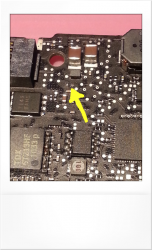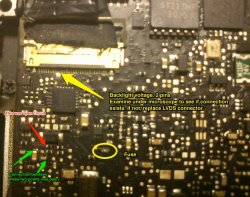MBP 13 Not Charging
It works great on battery power. Trouble is I can only charge the battery by connecting it to a different logic board.
Here's what I have observed.
No lights on magsafe plug - magsafe works fine on other machines.
If I unplug the battery from the board, the magsafe lights up bright green but flashes off - very briefly - about every second. Pulsing off?
As soon as I reconnect the battery, the light goes out.
No A/C power in system profiler - battery is good.
SMC reset - no change.
Board is very clean - no sign of any liquid or other damage/corrosion.
Check fuses, resistors and voltages referenced in this thread - all normal as far as I can see.
Just wondering if anyone recognizes the "pulsing off" green light as a symptom?
Any and all suggestions greatly appreciated!
It works great on battery power. Trouble is I can only charge the battery by connecting it to a different logic board.
Here's what I have observed.
No lights on magsafe plug - magsafe works fine on other machines.
If I unplug the battery from the board, the magsafe lights up bright green but flashes off - very briefly - about every second. Pulsing off?
As soon as I reconnect the battery, the light goes out.
No A/C power in system profiler - battery is good.
SMC reset - no change.
Board is very clean - no sign of any liquid or other damage/corrosion.
Check fuses, resistors and voltages referenced in this thread - all normal as far as I can see.
Just wondering if anyone recognizes the "pulsing off" green light as a symptom?
Any and all suggestions greatly appreciated!



